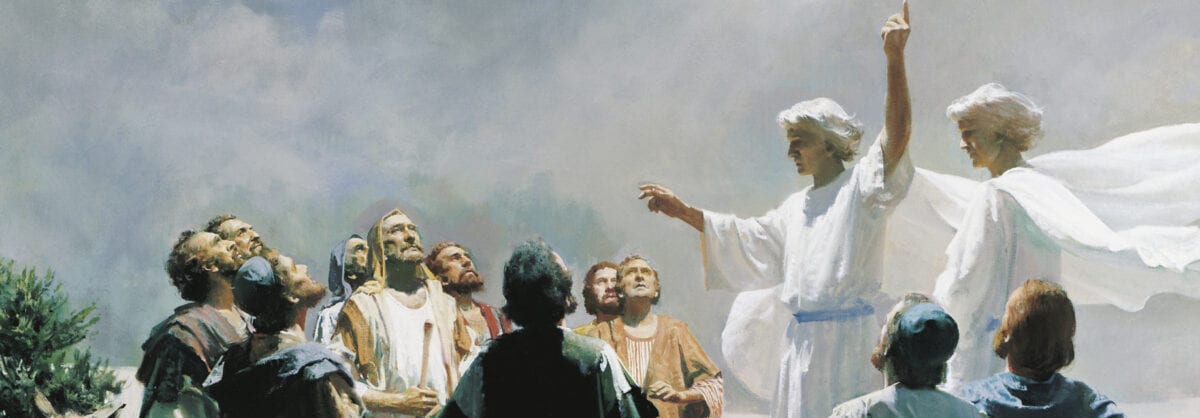
The Ascension A
Readings: Acts 1:1-11 Ephesians 1:17-23 Matthew 28:16-20
The Feast of the Ascension celebrates both the resurrected Jesus’ triumph over the power of sin and evil by his ascension to the right hand of the Father and also the apostles’ mission, empowered by the Holy Spirit, to witness to Christ’s victory throughout the world. Let us rejoice in Jesus’ enthronement in the words of the refrain of our responsorial psalm: “God mounts his throne to shouts of joy;/ a blare of trumpets for the Lord” (Ps 48).
The account of Jesus’ ascension in the first reading comes from the introduction to Luke’s second volume, the Acts of the Apostles. As with his gospel, Luke addresses Acts to Theophilus (“lover of God”). He recapitulates the events of the Gospel with special emphasis on Jesus’ commissioning the apostles to wait in Jerusalem to receive the power of the Holy Spirit who will send them as his witnesses to the whole world. In his summary of the Gospel Luke recalls Jesus’ actions and teachings until his ascension, his choice of the apostles, his suffering and death, his resurrection appearances over a forty day period in which he spoke of the kingdom of God and proved that he was alive, and his command not to depart from Jerusalem, but to await the Father’s promise of their baptism with the Holy Spirit. He prefaces his second account of the ascension (see Luke 24:50-53) with a dialogue between the apostles and Jesus at their last meeting. They ask, “Lord, are you at this time going to restore the kingdom to Israel?” But Jesus says that it is not for them to know “the times or seasons that the Father has established by his own authority.” Instead he promises: “. . . you will receive power when the Holy Spirit comes upon you, and you will be my witnesses in Jerusalem, throughout Judea and Samaria, and to the ends of the earth.” Then like Elijah and certain traditions associated with Moses, Jesus is “lifted up, and a cloud takes him from their sight.” For Luke this is Jesus’ enthronement as the triumphant Messiah and Son of Man at God’s right hand (cf. Dan 7:13 and Luke 1:32; Acts 2:22-36; 7:56). His exodus or departure has been a part of God’s plan from the beginning (cf. Luke 9:28-36; 9:51). Like the prophets Moses and Elijah who appeared with him in glory at the transfiguration to talk of his exodus (9:28-36), Jesus must leave physically for the Holy Spirit to be poured out on his successors who will carry on his work (see Deuteronomy 34 and 2 Kings 2). The “two men dressed in white garments” who stand beside the apostles as they witness the ascension may be Moses and Elijah (cf. Luke 9:28-36; 24:1-8). They do not allow the apostles to gawk at Jesus’ ascension, but rather assure them of his return as the Messiah/Son of Man who will establish his kingdom after their work of witnessing to him throughout the earth.
The Epistle reading is taken from the thanksgiving section of Ephesians in which the Pauline author prays that God, through the resurrected and ascended Christ, will give the Christian community, his body on earth, “a spirit of wisdom and revelation resulting in knowledge of him.” In Christ’s resurrection from the dead, ascension, and enthronement at God’s right hand, God has defeated the powers of evil that formerly ruled the world—“every principality, authority, power, and dominion and every name that is named.” God has put all things beneath Christ’s feet and given him “as head over all things to the church, which is his body, the fullness of the one who fills all things in every way.” Paul’s prayer is that the Christian community will have the eyes of their hearts enlightened by the risen and triumphant Christ so that they know “the hope that belongs to his (God the Father’s) call, what are the riches of glory in his inheritance among the holy ones, and what is the surpassing greatness of his power for us who believe.”
The Gospel reading of the commissioning of the disciples is the conclusion of Matthew and completes the main themes of the entire Gospel. As the triumphant Son of Man (cf. Daniel 7), the risen Jesus appears to the eleven disciples who have gone to Galilee, as Mary Magdalene and the other Mary had told them (Matt 28:9-10; cf. 26:32). When the disciples see him in his glory, they worship, but also are filled with doubt. Jesus then approaches them and assures them that he has triumphed over death and is now risen as the victorious Son of Man as he had repeatedly announced (Matt 16:21-28; 17:22-23; 20:17-19; 24:1-51; 25:31-46; 26:63-64). In Matthew’s Gospel the period between Jesus’ resurrection and his triumphant return as Son of Man in judgment is a time for the gospel to be carried by his disciples to all the nations (24:14). They are the emissaries of Jesus; to receive them is to receive him and the Father who sent him (10:40-42; 18:1-5; 25:31-46). Jesus has prepared them for this mission by his teaching in the five great discourses throughout the Gospel (5:1-7:29; 10:1-11:1; 13:1-53; 18:1-35; 23:1-25:46). Now he commissions them to make disciples of all nations, by “baptizing them in the name of the Father, and of the son, and of the Holy Spirit” and by teaching them to observe all that he has commanded them. Jesus, who is Immanuel, “God with us” (1:21-22), concludes by assuring them of his presence with them in this mission until his return in glory: “and behold, I am with you always, until the end of the age.”
No comments:
Post a Comment